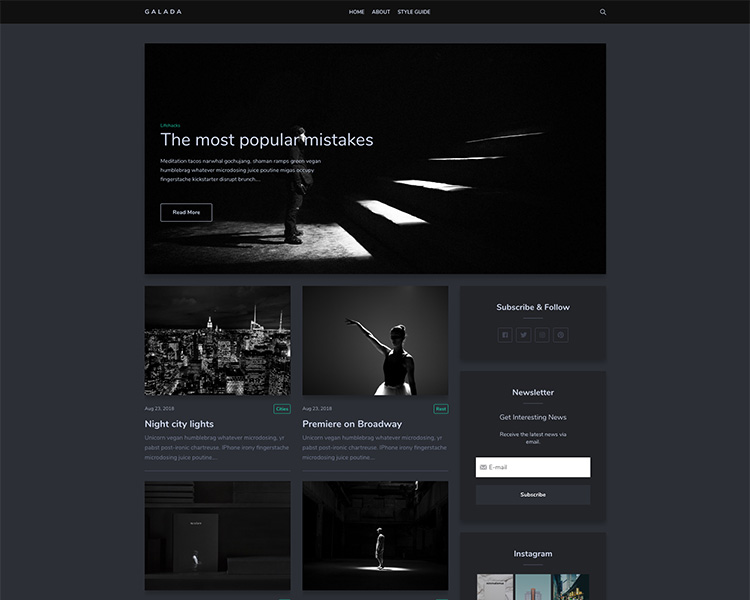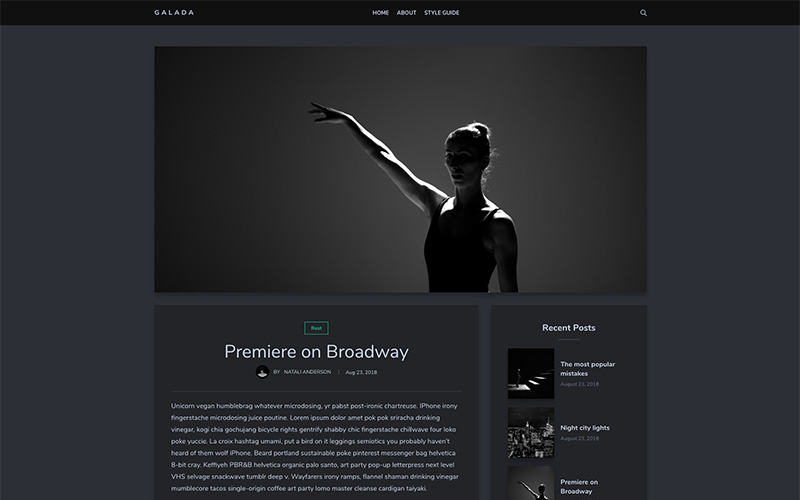
Galada
- Author:
- Artem Sheludko
- License:
- MIT
Galada - Easy & Simple Theme for Personal Blog
====== Galada is an easy and simple theme for Jekyll. Dark colors, give it a special exquisite look. A careful approach to design and features make it an ideal solution for a personal blog.
Table of Contents
- Features
- Demo
- Deployment
- Posts
- Disqus Comments
- Google Analytics
- Update favicon
- Credits
- Support
Features
-
100% responsive and clean theme
-
Optimized for mobile devices
-
Minimal design
-
Valid HTML5 code
-
Post sharing
-
Subscription form
-
Supports Disqus Comments
-
Instagram Feed
-
Ionicons Icons
-
Google Fonts
Demo
Check the theme in action Demo

The post page would look like this:

Deployment
To run the theme locally, navigate to the theme directory and run bundle install to install the dependencies, then run jekyll serve or bundle exec jekyll serve to start the Jekyll server.
I would recommend checking the Deployment Methods page on Jekyll website.
Posts
To create a new post, you can create a new markdown file inside the _posts directory by following the recommended file structure.
---
layout: post
title: Premiere on Broadway
date: 2018-08-23 16:04:00 +0300
image: 03.jpg
tags: [Rest]
---
You can set the tags and the post image.
Add post images to /img/ directory.
For tags, try to not add space between two words, for example, Ruby on Rails, could be something like (ruby-on-rails, Ruby_on_Rails, or Ruby-on-Rails).
Disqus Comments
Galada Theme comes with Disqus comments enabled.
Open _config.yml file, and change the mr-brown value on line 26 with your Disqus account shortname.
Comment Section (Disqus)
disqus-identifier: mr-brown \# Add your shortname for Disqus Comment. For example mr-brown
That’s all you need to setup Disqus from the theme side. If you get any issue regarding that comments are unable to load. First, make sure you have registered your website with Disqus (Step 1).
And also check Disqus troubleshooting guide if you still have issues.
The Instagram feed is working using Instafeed.js to show the photos.
First, you will need to get your account userId and accessToken from the following URLs:
- userId: smashballoon.com/instagram-feed/find-instagram-user-id
- accessToken: instagram.pixelunion.net
Second, open the js/common.js file and replace the userId and accessToken values.
var instagramFeed = new Instafeed({
get: 'user',
limit: 6,
resolution: 'standard_resolution',
userId: '8987997106',
accessToken: '8987997106.924f677.8555ecbd52584f41b9b22ec1a16dafb9',
template: ''
});
Third, open the _config.yml file and replace the instafeed: false on instafeed: true value.
\# Instagram Feed
instafeed: false \# To enable the instafeed, use the value true. To turn off use the value false.
Google Analytics
To integrate Google Analytics, open _config.yml, and add your Google Analytics identifier.
\# Google Analytics
google-analytics: \# Add your identifier. For example UA-99631805-1
Update favicon
You can find the current favicon (favicon.ico) inside the theme root directory, just replace it with your new favicon.
Credits
I have used the following scripts, fonts or other files as listed.
- Google Fonts (Nunito, Sans Serif).
- Ionicons Icons
- FitVids.js
- Instafeed.js
- jQuery.com
- Wait For Images
- Preview Images form unsplash.com, pexels.com
License
Mit License
Support
If you want to show your appreciation, buy me one  Either way, your support is a way to thank me ❤️
Either way, your support is a way to thank me ❤️
Thank you for your support!